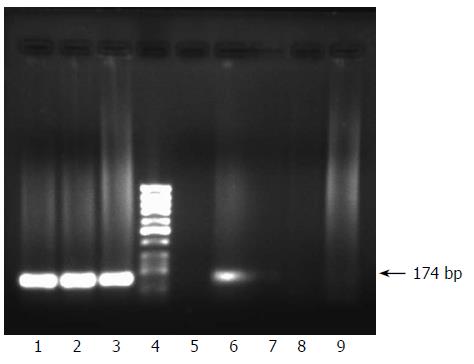Copyright
©2006 Baishideng Publishing Group Co.
World J Gastroenterol. Aug 14, 2006; 12(30): 4836-4842
Published online Aug 14, 2006. doi: 10.3748/wjg.v12.i30.4836
Published online Aug 14, 2006. doi: 10.3748/wjg.v12.i30.4836
Figure 1 Establishment of an in vitro infection experiment of HepG2 cells with serum of a HCV genotype 4-infected patient and monitoring success of infection by nested RT-PCR amplification of viral sense and minus strands.
The patient was confirmed to be infected with HCV as demonstrated by nested RT-PCR amplification of viral positive strand in the serum (lane 1), and both viral positive and negative strands (lane 2 and lane 3 respectively) in the peripheral blood mononuclear cells. After infection of the cells with the patient sera (see the detailed method in the materials and methods), cells were carefully washed and nested RT-PCR was carried out on the last wash to make sure that the culture medium contained no more viral RNA and results showed no amplified products (lane 5). At this stage we were sure that any detection of viral RNA within the cells could reflect successful viral adsorption and penetration. Three days after infection, RNA was extracted from both cells and their supernatant and nested RT-PCR for detection of both viral strands was carried out and results showed the presence of the sense strand in the cells (lane 6) but not in the supernatant (lane 7). The antisense strand was neither present in the cells nor in the supernatant (lanes 8, 9). Lane 4 is molecular weight standard DNA marker (Ǿ-X-174/HaeIII; Q-BIOgene, Germany).
- Citation: El-Awady MK, Tabll AA, El-Abd YS, Bahgat MM, Shoeb HA, Youssef SS, Din NGBE, Redwan ERM, El-Demellawy M, Omran MH, El-Garf WT, Goueli SA. HepG2 cells support viral replication and gene expression of hepatitis C virus genotype 4 in vitro. World J Gastroenterol 2006; 12(30): 4836-4842
- URL: https://www.wjgnet.com/1007-9327/full/v12/i30/4836.htm
- DOI: https://dx.doi.org/10.3748/wjg.v12.i30.4836









